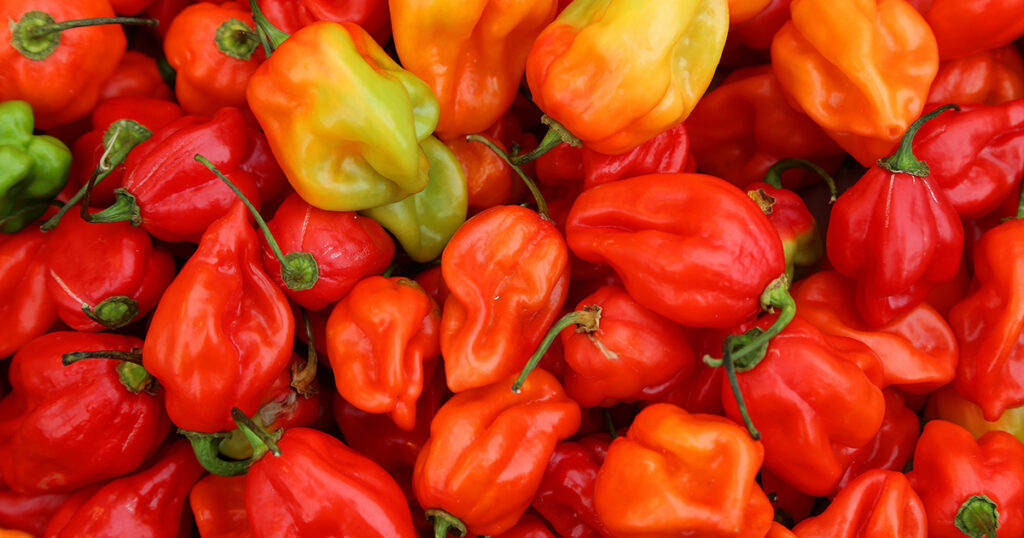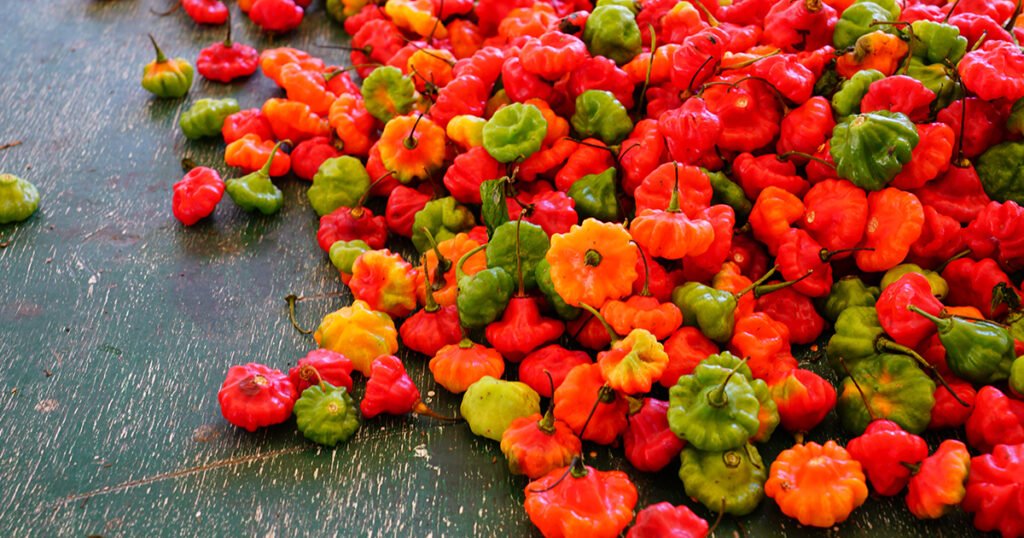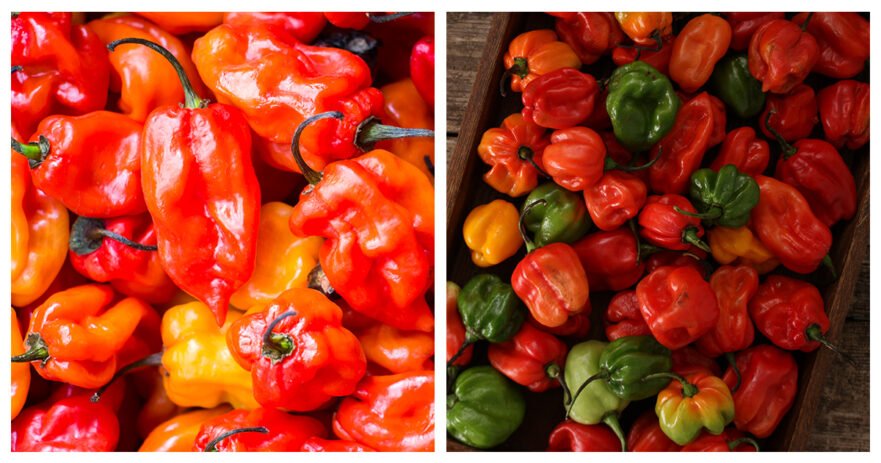When it comes to fiery peppers that pack a punch, the Habanero and the Scotch Bonnet rank high. These two chili varieties are often interchanged due to their similar shapes and potency, but they each have unique attributes that set them apart. Let’s delve into these two formidable chili peppers’ heat, flavor, and culinary applications.
| Habanero pepper | Scotch bonnet | |
| SHU | 100,000 - 350,000 | 100,000 - 350,000 |
| Median SHU | 225,000 | 225,000 |
| Flavor | Fruity and floral, sweet with a significant heat | Sweet, fruity, tropical, citrusy |
| Species | Capsicum chinense | Capsicum chinense |
| Origin | Peru, today biggest producer is Yucatan Peninsula, Mexico | South America |
| Uses | Salsas, hot sauces, jerk seasoning, marinades, etc. | Sauces, dry rubs, marinades, salsas, soups, curries |
Table of contents
What is Habanero Pepper?

The Habanero pepper, recognized by its small, lantern-like shape and color ranging from green to red and orange, traces its roots to the Amazon River basin and is a staple in Mexican and Caribbean cuisines.
These peppers boast a heat from 100,000 to 350,000 Scoville Heat Units (SHU), qualifying them as one of the hottest. However, the Habanero isn’t just hot; it has a fruity, tangy flavor with floral and smoky undertones that give depth to its fiery nature.
Habaneros are versatile, applicable in everything from salsas and marinades to hot sauces and spicy desserts. Their unique flavor and intense heat enhance dishes, making them a favorite for those who love a spicy culinary adventure.
Growing habaneros at home is a rewarding endeavor, as they flourish in sunny conditions, and their vibrant colors provide aesthetic appeal to any garden.
What is Scotch Bonnet Pepper?

The Scotch Bonnet pepper, which resembles a traditional Scottish bonnet, hails from the Caribbean. It’s an indispensable ingredient in Jamaican and other Caribbean cuisines, lending its distinctive flavor to various dishes.
Scotch bonnets hold a Scoville rating similar to habaneros, ranging from 100,000 to 350,000 SHU. Despite their fierce heat, they offer a sweet, somewhat fruity flavor.
Their robust flavor and heat make them an essential ingredient in Caribbean classics like Jamaican jerk chicken. They also shine in hot sauces, curries, and stews, providing a burst of heat balanced with an underlying sweetness.
Growing Scotch Bonnets is feasible, as they thrive in warm climates and add a pop of color to your garden.
Similarities between Habaneros and Scotch Bonnet peppers?
Habaneros and Scotch Bonnets come from the Capsicum chinense family and are nearly identical in heat. They possess a similar shape, albeit Scotch Bonnets have a squatter, more defined bonnet shape.
Their similar heat profiles make them interchangeable, and both can be used fresh, dried, or in sauces.
You’ll find both peppers making star appearances in salsas, hot sauces, and spicy dishes requiring a serious kick.
In addition to their heat, both habaneros and Scotch bonnets boast a unique, fruity flavor, making them more than just spicy additives. They also share a similar color range, ripening from green to intense red, orange, yellow, and brown.
Finally, both peppers are widely used in Caribbean cuisine, where their intense heat and flavor help define the region’s iconic dishes.
What are the differences between Habanero and Scotch Bonnet peppers?
While both peppers boast a sweet and fruity flavor, the nuances vary.
Habaneros have a citrusy and floral undertone, often reminiscent of tangerines or papaya, with a hint of smokiness. In contrast, Scotch bonnets deliver a flavor profile leaning more towards tropical sweetness, evoking flavors of mangoes and pineapples, making them ideal for dishes with a sweet-spicy balance.
Visually, Scotch bonnets tend to be smaller and possess a distinctive ‘bonnet’ shape from which they derive their name. On the other hand, Habaneros usually appear more lantern-like and bigger.
Lastly, despite their interchangeability, each pepper has unique applications that best harness its flavor. Habaneros are often used in Mexican dishes, hot sauces, and infused oils. With their distinct tropical sweetness, Scotch Bonnets are a staple in Jamaican and Caribbean cuisines, finding their way into jerk seasoning, hot sauces, and curry dishes.
Which Pepper Should You Choose?
When deciding between Habanero and Scotch Bonnet, personal taste, culinary tradition, and desired flavor nuances should guide you. Both peppers deliver a fiery kick, transforming ordinary dishes into something exceptional.
Habanero thrives in Mexican and Caribbean recipes with its sweet, citrusy flavor, adding an unexpected zing. Conversely, Scotch Bonnet’s tropical sweetness shines in Jamaican and other Caribbean classics, skillfully balancing spiciness and fruity undertones. Regardless of your choice, handle these capsaicin-packed peppers carefully, as a little goes a long way.
FAQ about Habanero and Scotch Bonnet
What dishes are best suited to Habanero peppers?
Habanero peppers are versatile and shine in a variety of dishes. Their unique blend of citrusy, sweet flavor and intense heat works brilliantly in Mexican and Caribbean cuisine. They're great in salsas, hot sauces, marinades, and spicy desserts. Experimenting with Habaneros in your cooking leads to deliciously fiery culinary creations.
How can I use Scotch Bonnet peppers in cooking?
Scotch Bonnet peppers are a staple in Caribbean cooking, where their distinctive sweet, fruity heat enhances classic dishes like jerk chicken. They're also excellent in curries, stews, and hot sauces, delivering a balanced heat with a hint of tropical flavor. Remember to use them sparingly to avoid overwhelming the dish.
Are Habanero and Scotch Bonnet peppers the same?
Despite their similarities, Habanero and Scotch Bonnet peppers are distinct. Habaneros offer a citrusy flavor with a hint of flowers and smoke, whereas Scotch Bonnets bear a tropical sweetness, evoking mangoes and pineapples. The difference also extends to their physical appearance - Scotch Bonnets are slightly smaller with a pronounced 'bonnet' shape, while Habaneros have a larger, lantern-like appearance. Each pepper's unique flavor nuances lend themselves to specific cuisines: Habaneros appear in Mexican dishes and hot sauces, while Scotch Bonnets are used in Jamaican and Caribbean recipes.
Can I substitute Habanero for Scotch Bonnet in recipes?
Yes, Habaneros can be used as a substitute for Scotch Bonnets in recipes, and vice versa, because they have similar heat. However, it's essential to note that they have slightly different flavor profiles. Scotch Bonnets offer a fruitier, sweeter flavor, while Habaneros have a citrusy note.
How can I reduce the heat of Habanero and Scotch Bonnet peppers?
The heat in peppers is primarily due to capsaicin, a compound concentrated in the seeds and the white pith. You can remove these parts to reduce the heat before using the peppers. However, always carefully handle these fiery peppers, preferably with gloves, to avoid skin irritation.
Can I grow Habanero and Scotch Bonnet peppers at home?
Absolutely! Both Habanero and Scotch Bonnet peppers can be grown at home. They thrive in sunny conditions and well-draining soil. You can enjoy these vibrant, flavorful peppers from your garden with proper care. However, remember they are hot peppers, so keep them away from children and pets.
